Also featured: edible plates, the history of butter chicken, bamboo shoots and traveling with salmon.
In the Pinoy reportoire of ‘saba-based merienda’ there’s pritong saba – frying it in oil until both sides are slightly toasted, the the sugar-crusted banana cue (which, come to think of it, is our answer to fancy candied apples), the turon (fried in spring roll wrappers), the minatamis (banana preserved in sugar syrup), and of course, the maruya (banana pancakes). Interestingly, in Vietnam they grill bananas (the photos suggest something akin to the ubiquitous saba) and dip it in slightly sweetened gata (coconut milk).
Read Tamara Adler’s guide on maximising citrus peels, which can also apply to kalamansi, ponkan, kiat-kiat and dalanghita. What I love about it is its near-poetic description of peels, usually relegated into the province of discards, as “an olfactory herald, a creator of the anticipatory gust that wafts upward when you first dig a nail into a mandarin, or cut a lemon in half.” For me, though, the smell will always remind me of grandmothers (as well as my mother) nibbling on them during commutes.
The Maranao has an intriguing take on fish croquettes (called pisasati in the local language) where they use grilled tuna (readily available in the market as tiyapa or pitapa) and their wonderful condiment palapa. The latter is admittedly one of those Filipino ingredients that’s hard to get hold of outside Mindanao, so I imagine it is hard for anyone who haven’t tried it to approximate how it tastes… although for those who live in Manila, the Muslim Town in Quiapo abounds with the stuff, and it’s delicious.
This Japanese gohan (meal) of chicken wings simmered in vinegar is a lot similar to our adobo (although it’s not the dry variant that I like), down to the ingredients and that balance of sugar, soy and vinegar. The article also offers scientific insight on why chicken bones come apart cleaner when cooked in vinegar: “This happen[s] as the collagen in the tendon that connects the bone and muscle melt[s] out (sic) and the cartilage [is] easily released from the bone. Vinegar also serves to dissolve the calcium in the bone so that the amount of ingestible (sic) calcium increased by about 1.8 times.”
The similarities end there. The Japanese has a tradition of using the collagen-rich jellied chicken wing broth (“nikogori”), which we know as the by-product of day-old adobo in the fridge, as a topping to boiled cabbage and other leafy vegetables.
- For those who suffer the indignity of washing the dishes in between breaks from working from home: edible plates and trays in Japan.
- Labong (bamboo shoots), something I only encounter as sliced and shrink-wrapped (in high-end supermarkets in Manila) and canned (mostly in those jack-of-all-trades “general merchandise” stalls beside any palengke) is simmered in dashi stock and soy sauce as rice topping.
- I stand corrected: butter chicken (murgh makhani) is Indian through and through, borne about by the need to feed a busload of refugees during the disastrous Partition of India.
